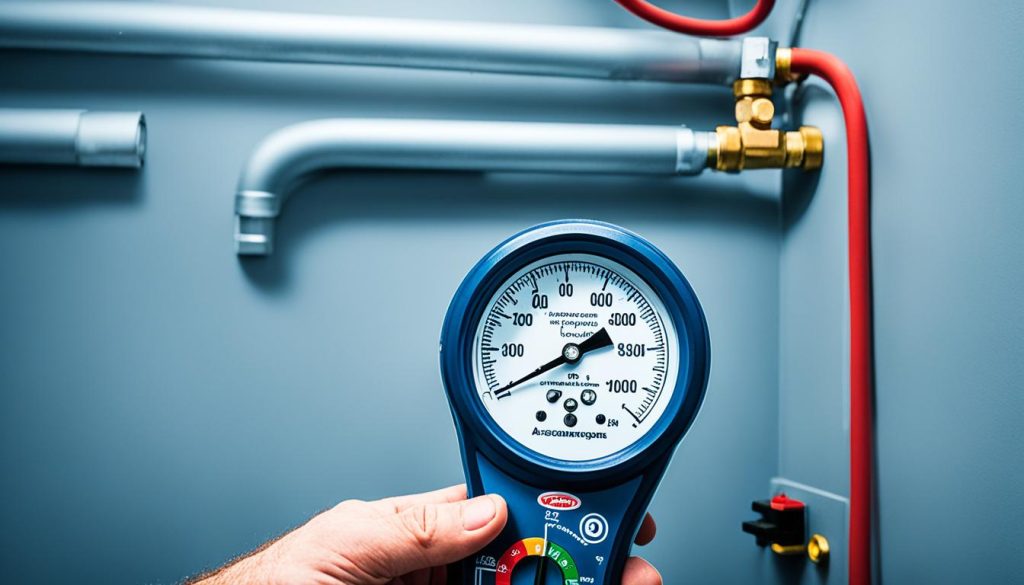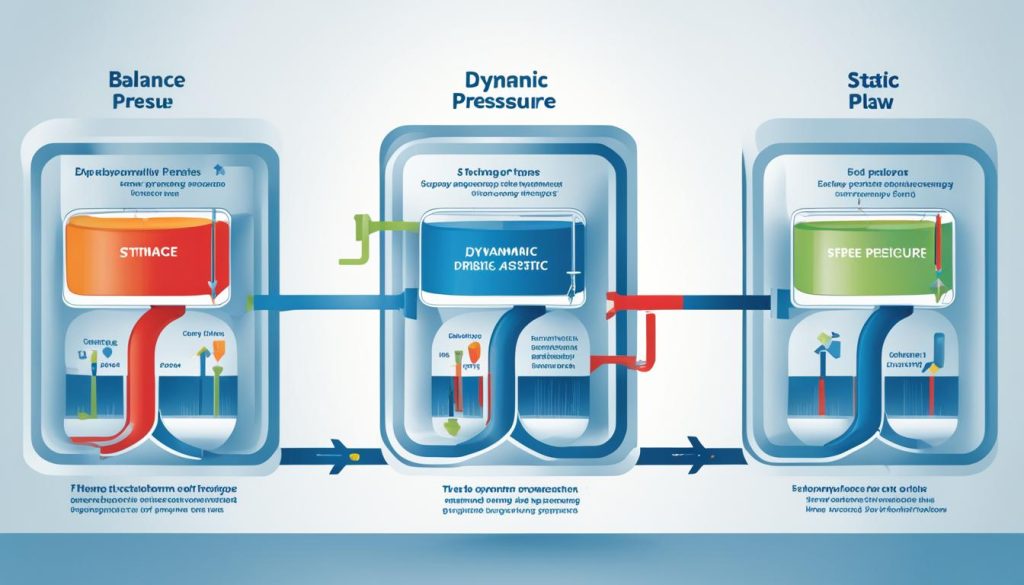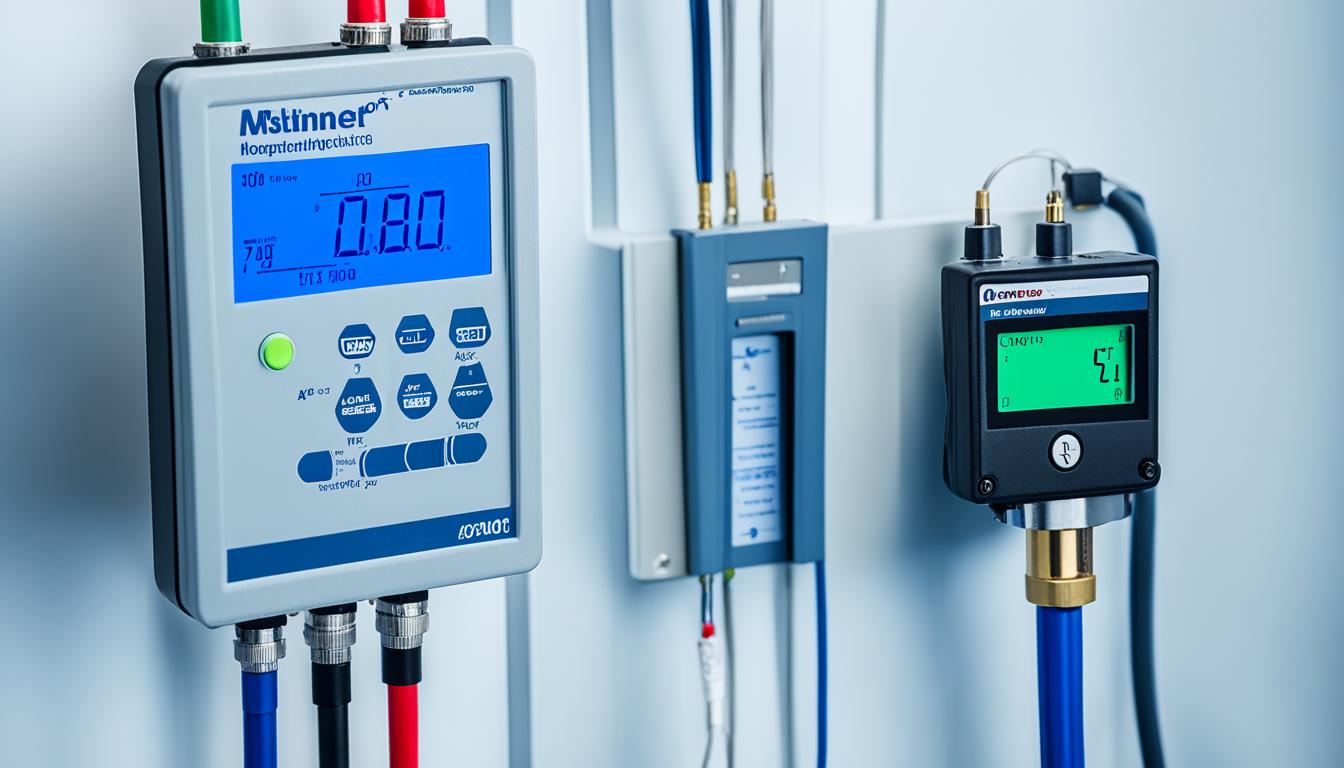Did you know that improper static pressure in HVAC systems can lead to a loss of up to 40% in energy efficiency?
Static pressure testing is a crucial aspect of HVAC system maintenance and performance optimization. By measuring the resistance to airflow in the ductwork and other components of the system, static pressure testing helps identify potential issues and inefficiencies. Proper understanding and interpretation of static pressure measurements can significantly improve the functionality and efficiency of HVAC systems.
Key Takeaways:
- Static pressure testing is essential for maintaining HVAC system efficiency.
- Improper static pressure can lead to a significant loss in energy efficiency.
- Understanding static pressure measurements helps identify issues and inefficiencies.
- Proper interpretation of static pressure readings allows for necessary adjustments and improvements.
- Investing in static pressure management ensures optimal comfort and energy efficiency.
The Importance of Static Pressure in HVAC Systems
When it comes to HVAC systems, static pressure plays a vital role in ensuring the efficiency and proper functioning of the system. Static pressure refers to the resistance to airflow within the ductwork and other components of the system. By maintaining appropriate static pressure levels, HVAC systems can deliver optimal performance and prevent a range of issues, including reduced airflow, noisy operation, and inconsistent temperature control.
Understanding static pressure is crucial for identifying problems in installation, duct configuration, and system operation. When static pressure is too high, it may indicate issues such as undersized ductwork, clogged filters, or closed dampers. On the other hand, low static pressure can result from leaky ducts or an underpowered blower motor.
By measuring and monitoring static pressure, HVAC professionals can make timely adjustments and improvements to enhance the system’s overall efficiency and performance. This proactive approach allows for the identification of potential issues before they escalate, resulting in improved comfort and energy savings for homeowners.
Proper static pressure management is particularly important for maintaining a balanced airflow throughout the system. When static pressure is within the recommended range, airflow is distributed evenly, ensuring consistent temperature control in different areas of the building. This helps prevent hot and cold spots that can be disruptive and uncomfortable.
Static pressure also affects the overall energy efficiency of HVAC systems. When static pressure is too high, the system has to work harder to push air through the ducts, which increases energy consumption and decreases efficiency. Conversely, low static pressure can result in decreased airflow and reduced system performance.
For HVAC professionals, a thorough understanding of static pressure and its impact on system efficiency and function is essential. By implementing proper static pressure management techniques, such as adjusting ductwork, sealing leaks, and maintaining appropriate fan speeds, professionals can optimize system performance, enhance energy efficiency, and ensure customer satisfaction.
How to Measure Static Pressure
Measuring static pressure is an essential step in assessing the performance of an HVAC system. By using a manometer, you can accurately measure static pressure and identify any potential issues that may be affecting airflow and system efficiency.
To measure static pressure, you will need to access both the supply and return points of the HVAC system. Using a drill, create small holes in these areas and insert the manometer probes to measure the pressure at each location. The manometer provides readings in inches of water column, which is the standard unit of measurement for static pressure.
Once you have obtained the measurements from both the supply and return points, you can calculate the overall static pressure by summing up the readings. This will give you a better understanding of the system’s overall resistance to airflow.
In general, a reading above 0.5 inches indicates high static pressure, which can negatively affect the performance and efficiency of the HVAC system. It is important to address high static pressure as it can lead to reduced airflow, increased energy consumption, and system malfunctions.

Having a clear understanding of static pressure measurement and utilizing a manometer can help HVAC professionals accurately diagnose and resolve issues related to airflow and system performance.
Interpreting Static Pressure Readings
When it comes to interpreting static pressure readings in your HVAC system, the focus is on total pressure. Understanding these readings can provide valuable insights into the performance and efficiency of your system.
If you notice drops or inconsistencies in your static pressure readings, it may indicate problems with your air conditioning. These issues can have a negative impact on the performance of your blower motor. For example, high static pressure can result in reduced airflow, leading to discomfort and uneven temperature control in your home. On the other hand, low static pressure may indicate leakage in your ductwork or low fan speed, resulting in poor system performance.
By interpreting static pressure readings accurately, you can diagnose potential issues with your system and determine the necessary repairs or adjustments. This knowledge is essential for optimizing airflow, maintaining consistent temperatures, and ensuring the overall efficiency of your HVAC system.
Static Pressure Readings in HVAC Systems
| Pressure Range | Interpretation |
|---|---|
| 0.1 – 0.5 inches | Ideal static pressure range for optimal system performance |
| Above 0.5 inches | High static pressure, indicating potential airflow issues and reduced performance |
| Below 0.1 inches | Low static pressure, suggesting leakage in ductwork or insufficient fan speed |
By referring to this table, you can assess your static pressure readings and gain a better understanding of your HVAC system’s performance. If your readings fall outside the ideal range, it may be necessary to consult with a professional technician to address any underlying issues and optimize your system’s airflow and efficiency.
The Balance Between Static Pressure and Dynamic Pressure
In HVAC systems, both static pressure and dynamic pressure are important for achieving optimal efficiency and performance. Static pressure refers to the resistance encountered by airflow within the system, while dynamic pressure represents the force exerted when the air is in motion.
The balance between static and dynamic pressures is crucial for the HVAC system to operate smoothly and efficiently. When the static pressure is too high, it can hinder airflow and reduce system performance. On the other hand, if the static pressure is too low, it may indicate issues such as leaking ductwork or a poor seal, leading to energy wastage and inefficiency.
To ensure the system functions at its best, a harmonious balance between static and dynamic pressures must be maintained. This balance allows for proper airflow, efficient operation, and optimized performance, resulting in improved energy efficiency and cost savings.

How Static and Dynamic Pressure Affect Efficiency and Performance
Static pressure directly influences the ability of the HVAC system to distribute conditioned air throughout the space. When static pressure is too high, it restricts airflow, causing the system to work harder to overcome the resistance. This results in reduced efficiency, increased energy consumption, and potential equipment strain.
Dynamic pressure, on the other hand, plays a crucial role in ensuring effective air circulation and ventilation. It enables the system to deliver the required air volume to different zones or rooms, ensuring proper cooling or heating. By maintaining a balanced ratio between static and dynamic pressures, the HVAC system can perform optimally, providing consistent comfort and energy-efficient operation.
Table: Comparing Static Pressure and Dynamic Pressure
| Factor | Static Pressure | Dynamic Pressure |
|---|---|---|
| Definition | The resistance encountered by the airflow within the system. | The force exerted when the air is in motion. |
| Measurement | Expressed in inches of water column (in. WC). | Generally not measured directly but inferred from airflow and velocity measurements. |
| Effect on Efficiency | High static pressure hampers airflow, decreases efficiency, and increases energy consumption. | Dynamic pressure enables effective air circulation, facilitating efficient cooling and heating. |
| Impact on Performance | High static pressure can cause system malfunctions, discomfort, and increased noise levels. | Optimal dynamic pressure ensures even airflow distribution, maintaining consistent comfort. |
The balance between static pressure and dynamic pressure is a key factor in achieving efficient and reliable HVAC operation. By monitoring and managing both pressures, HVAC professionals can optimize system performance, improve energy efficiency, and enhance overall customer satisfaction.
System Components and Static Pressure
Proper installation and selection of system components are critical factors in maintaining optimal static pressure levels. When system components are poorly installed or the ductwork is improperly configured, it can lead to high static pressure, which ultimately reduces the efficiency and function of the HVAC system. As a professional, I prioritize quality ductwork installation, which is key to combating static pressure issues. Additionally, considering alternative solutions such as underfloor air distribution systems can be beneficial, as they operate at lower static pressure ratings.
These are a few examples of system components that contribute to static pressure. Each component should be carefully selected and installed to ensure optimal performance and minimal air pressure resistance.
Troubleshooting Static Pressure Issues
When it comes to static pressure issues in your HVAC system, it’s important to identify and address the root causes for optimal performance. Here are some common troubleshooting steps:
- Airflow Blockage: Check for any obstructions in the ductwork that may be causing a blockage. Clearing away debris or removing any physical barriers can help restore proper airflow.
- Closed Dampers: Ensure that all dampers in the system are fully open. Closed dampers restrict airflow and can lead to high static pressure. Adjusting the dampers to the correct position can improve system efficiency.
- Improper Transitions: Incorrectly sized or improperly installed transitions can cause airflow issues and increase static pressure. Verify that all transitions are properly aligned and that there are no air leaks or restrictions.
- Equipment Problems: Faulty equipment, such as undersized blower motors or clogged filters, can contribute to static pressure issues. Inspect and clean equipment regularly to maintain optimal performance.
- Duct Renovation: In some cases, ductwork may need renovation or repair to address static pressure problems. Consulting with a professional HVAC technician can help determine the appropriate steps for duct modification or replacement.
Addressing and resolving static pressure issues is crucial for maintaining system efficiency and preventing further damage. By troubleshooting and taking appropriate action, you can ensure that your HVAC system operates optimally, providing consistent and comfortable airflow throughout your home.
The Value of Proper Static Pressure Management
Proper static pressure management plays a vital role in maximizing the efficiency and performance of your HVAC system. By understanding and measuring static pressure, you gain valuable insights into the functionality of your system. This knowledge allows for targeted duct renovation work and improvements in airflow, resulting in better comfort and energy efficiency.
Investing in a well-designed and balanced duct system is more impactful than simply upgrading equipment. A poorly designed duct system can lead to increased static pressure, reduced airflow, and decreased system efficiency. By ensuring proper airflow through a well-configured duct system, you can optimize the performance of your HVAC system and minimize energy wastage.
Static pressure management is not just about installation; it also plays a crucial role in renovation work. As you undertake duct renovation projects, paying attention to static pressure levels ensures that the modified system operates efficiently. By considering factors such as proper duct sizing, number of registers, and strategic placement of dampers, you can maintain optimal static pressure levels throughout your HVAC system.
When it comes to static pressure management, relying on the expertise of experienced HVAC professionals is key. These professionals have the knowledge and skills to accurately measure static pressure, identify pressure imbalances, and recommend the appropriate solutions. By working with a knowledgeable HVAC professional, you can ensure that your system operates at peak performance, providing optimal comfort and energy efficiency.
